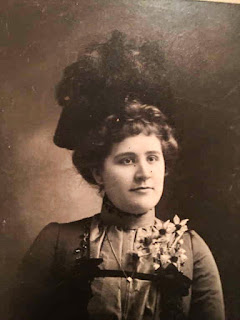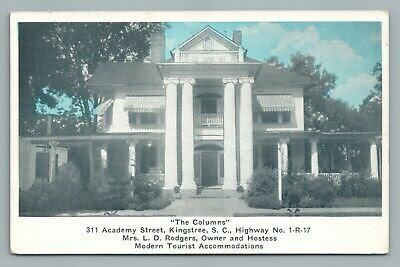This week we'll take another look at Kingstree's Winter Colony. This time the article is from the December 17, 1930, issue of the News & Courier under the headline "Baruch and Ralph Pulitzer Parties Hunt Williamsburg." The sub-head reads: Men and Women May Be Seen Tramping Fields Daily Accompanied By Highly Bred Dogs; DuPonts Bring Friends to Preserve.
Bernard Baruch shown with birds after a hunt.
Source: Baruch College Archives
"The tourist season hereabout is in full swing. Hardly a day passes that visitors from states farther north are not seen, clad in hunting togs, accompanied by highly bred dogs, somewhere about the woods and fields. Bernard M. Baruch has brought several parties of his friends and guests to hunt quail on his preserve in the Indiantown section while guests of Ralph Pulitzer at his hunting lodge, Burrows Hall, are enjoying the birds on his preserve in this same section.
"Among others who have been hunting in Williamsburg County within the last week are: Mr. and Mrs. Howard Haddon, Robert Goelet, Baxter Jackson of New York, and Miss Betty Tater of England. These were guests in the home of Mr. and Mrs. Leroy Epps. They found partridges in plenty on the old McElveen place in the Bethel community. They found sunshine and balmy weather, both of which appealed to them equally as much as did the partridges.
"Another party composed of Mr. and Mrs. Eugene DuPont, of Wilmington, Delaware; Mr. and Mrs. Ervin of New York; Mr. Nightingale of Boston, and Mrs. Dibble of Philadelphia, have been guests of Mr. and Mrs. Epps while on a hunting trip in this section. Mr. DuPont, who is a member of the DuPont-Emerson Company, holds a lease over 6,000 acres of land as a hunting preserve about eight miles out of Kingstree on the Charleston highway. They returned each day with bag limits and reported the shooting fine. The women of the party are said to be almost as good shots as the men.
"Visitors from other states come for other purposes than sports in the field. Reports from various of the tourist homes show that the great and the near great pass through, some stopping for a night, some for a weekend, and some for a longer visit. At the Green Villa, Capt. Singer of the United States was a visitor who liked Kingstree and the climate so well that he decided to stop over for a weekend. Capt. Singer was accompanied by his wife and his daughter, Miss Helen Singer, who had recently returned from abroad where she had been studying. Dr. Hallock, an eye, ear, nose, and throat specialist of Saranac Lake, NY, with Mrs. Hallock also were recent guests of the Green Villa.
"At the Columns have been Mr. and Mrs. Charles Lenhardt of Old Fort, NY. Mr. Lenhardt is a musician now playing in the Daytona Beach orchestra. He was formerly a member of Sousa's Band, having played the piccolo and flute.
"Another guest of interest at the Columns was a New York artist of some note. He amused persons here by telling of his summer home he had built in Maine according to his own ideas of comfort. It seems it aroused considerable curiosity among the natives until they learned the fact that he was an artist, then they were no longer interested, claiming artists are a "crazy bunch" anyway and what more would you expect?
"Among the guests registered of late at The Florida have been Mr. and Mrs. Robert Ingersoll. Mr. Ingersoll being the son of the famous watch-maker; Judge Cleary and Mrs. Cleary of Miami, FL; William MacGrail, manager of the South Harrison Hotel of Clearwater, FL; and Mrs. Hailan Prapp, president of the Women's Club of Miami.
"The Cottage Tea Room still receives many passing visitors of interest. Bits of conversation gathered while these are about the tables give the impression that the majority of the visitors from points farther north find the climate of coastal Carolina agreeable.
"B.M. Baruch's name leads the list of interesting visitors on the register of the Kingstree Hotel, while just across the street at the Charles Henry Hotel are names of guests from Maine, New York, New Jersey, and some of the mid-west states. One couple from New York recently came to spend one night and remained one week. They have been going to California, they told the management but decided to try Florida this winter. They left, planning to return to Kingstree for a month. They went into the outskirts of town where cotton was still to be found in the fields and picked some of that and gathered pine cones to take back home with them. They expressed themselves as delighted with the climate here and the natural scenery.
"A party of fifteen making the trip from New York to Miami on one of the big buses have already made arrangements with the Charles Henry Hotel to prepare plate lunches on the twentieth of this month as Kingstree is the point they have selected for their lunch hour.
"A party of North Carolina sportsmen recently stopped at the Charles Henry while they enjoyed a hunt in the nearby preserves. They returned to North Carolina with more than one hundred birds and said there were plenty more in the fields.
"At the Dixie Cabins a few nights ago was a Russian artist whose specialty is portraits. He has a studio in New York City. There, too, stopped this week a couple from New York state who have been going to California for the winters. They are trying out Florida this year but like the climate so well in this part of South Carolina that they are not anxious to travel farther south.
"Service station men claim that not as many are going south this winter as went last, but they think the greater number will come later. The conversation of many passing through centers on the widespread depression about which opinion varies. Some express themselves as feeling optimistic toward the outlook, while others say they can see no gleam of light ahead. There are tales of being routed south via other roads, but some state that Route 17, since it has been discovered and tried out, will alway prove the most popular route south, it being nearer and better than other routes suggested farther up the road.
Carolyn Van Blarcom
"Another tourist of distinction recently in Kingstree was Miss Carolyn Van Blarcom of New York City, who is author of several books that have proven popular with the reading public and of stories for certain of the "big four" magazines. Miss Blarcom who has traveled extensively about the world is especially interested in the study of the southern Negro from his tribal ancestors of Africa. Miss Blarcom was at one time health editor of Delineator."
Note: Route 17 mentioned in this article is today's US Highway 52 (Longstreet St.) The Cottage Tea Room, opened in 1929 by Mrs. T.C. Jacobs and Mrs. W.N. Jacobs, was located in the old Jacobs home on the corner of Main and U.S. Highway 52, where Hardee's is now. A side porch of the house had been converted into the tea room with screens and was lighted by wrought-iron lanterns. Tables, chairs, and buffet were painted Chinese red with black trim.











